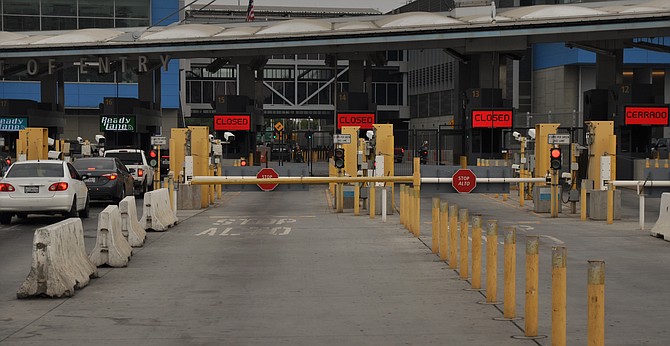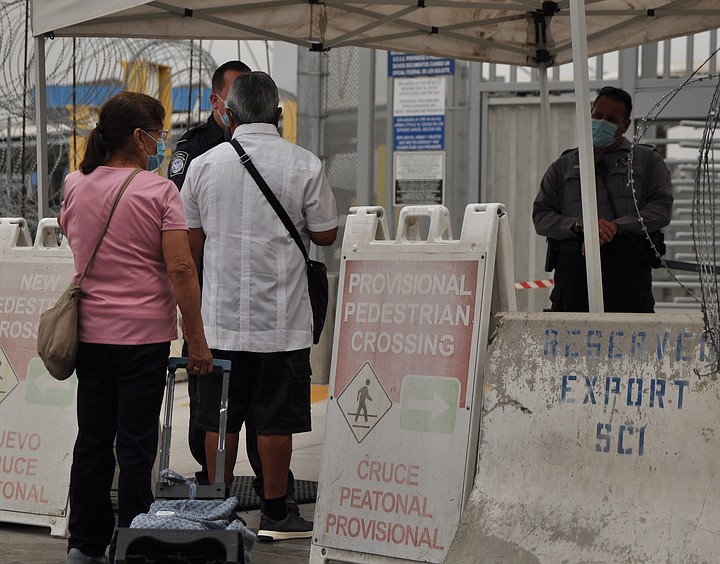 Facebook
Facebook
 X
X
 Instagram
Instagram
 TikTok
TikTok
 Youtube
Youtube

Waiting times like last Monday at the Tijuana-San Ysidro border had never been seen before, up to 12 hours to get through the line to cross into the U.S. This is the consequence of new measures to contain non-essential border crossing, applied last Friday. Two to three gates were open last weekend, compared to the normal 10-13 gates.
Since Saturday, waiting times of five or six hours were reported; even one 87-year-old woman died while waiting in line, the Tijuana police said. And for Sunday through Monday these time lapses doubled.

Like Gil Carrillo, thousands of Mexican-Americans that cross the border daily, could do nothing more than line up earlier than the usual. This time he waited 12 hours in a five-mile-long line that almost got connected with the other waiting line to cross via Otay Mesa.
Coming from Tijuana, Carrillo got in line at 10:30 pm Sunday night and didn’t cross until 11 am Monday, a delay which made him miss his job. “I work at San Diego Naval Supply Center as a welder. We are considered essential, so for me it’s not great that I have to cross daily. I hope it won’t repeat but a friend of mine who is a CBP (Customs and Border Protection) agent said weekends will be the same” he said.
Gil remembered that last time he waited seven hours was in 2001, the same as Irene Flores, a newspaper vendor with more than 20 years selling at the border. “When 9/11 happened there were long lines as well because each car was inspected, but not like this.” Despite the hundreds of potential customers passing by her stand, the stress of waiting for hours didn’t help her to sell at all, she added.
People kept their cars off in order to save gas and pushed them when the line moved on, vehicles broke down because of engines overheating, drivers cut the line in front of people who had waited for hours and confused, frustrated faces were a common sight. It was a tense atmosphere.
While this traffic chaos was happening, Mexican-Americans were encouraging each other on social media to complain against these measures via the CBP’s website. But at the same time Tijuanenses were complaining, on the same social media pages, about the traffic this causes in Mexico. “Why do US citizens (Mexican-Americans) live here in my town and make all this chaos? Can’t you all afford life there?”
For people like Patricia who works in San Diego, it is impossible to rent there in the current situation unless you have relatives living on the U.S side. Otherwise you need to cross daily. “A friend of mine moved with their uncles to Ramona, just to avoid the daily border crossing,” she said.
But the ones that live in San Diego and don’t cross regularly were taken by surprise, like Pedro Sanchez who was coming back from spending time with his family in Tijuana. “I’m thinking to stop crossing for a while,” said Sanchez about the long lines to make it back to San Diego.


Waiting times like last Monday at the Tijuana-San Ysidro border had never been seen before, up to 12 hours to get through the line to cross into the U.S. This is the consequence of new measures to contain non-essential border crossing, applied last Friday. Two to three gates were open last weekend, compared to the normal 10-13 gates.
Since Saturday, waiting times of five or six hours were reported; even one 87-year-old woman died while waiting in line, the Tijuana police said. And for Sunday through Monday these time lapses doubled.

Like Gil Carrillo, thousands of Mexican-Americans that cross the border daily, could do nothing more than line up earlier than the usual. This time he waited 12 hours in a five-mile-long line that almost got connected with the other waiting line to cross via Otay Mesa.
Coming from Tijuana, Carrillo got in line at 10:30 pm Sunday night and didn’t cross until 11 am Monday, a delay which made him miss his job. “I work at San Diego Naval Supply Center as a welder. We are considered essential, so for me it’s not great that I have to cross daily. I hope it won’t repeat but a friend of mine who is a CBP (Customs and Border Protection) agent said weekends will be the same” he said.
Gil remembered that last time he waited seven hours was in 2001, the same as Irene Flores, a newspaper vendor with more than 20 years selling at the border. “When 9/11 happened there were long lines as well because each car was inspected, but not like this.” Despite the hundreds of potential customers passing by her stand, the stress of waiting for hours didn’t help her to sell at all, she added.
People kept their cars off in order to save gas and pushed them when the line moved on, vehicles broke down because of engines overheating, drivers cut the line in front of people who had waited for hours and confused, frustrated faces were a common sight. It was a tense atmosphere.
While this traffic chaos was happening, Mexican-Americans were encouraging each other on social media to complain against these measures via the CBP’s website. But at the same time Tijuanenses were complaining, on the same social media pages, about the traffic this causes in Mexico. “Why do US citizens (Mexican-Americans) live here in my town and make all this chaos? Can’t you all afford life there?”
For people like Patricia who works in San Diego, it is impossible to rent there in the current situation unless you have relatives living on the U.S side. Otherwise you need to cross daily. “A friend of mine moved with their uncles to Ramona, just to avoid the daily border crossing,” she said.
But the ones that live in San Diego and don’t cross regularly were taken by surprise, like Pedro Sanchez who was coming back from spending time with his family in Tijuana. “I’m thinking to stop crossing for a while,” said Sanchez about the long lines to make it back to San Diego.
Comments